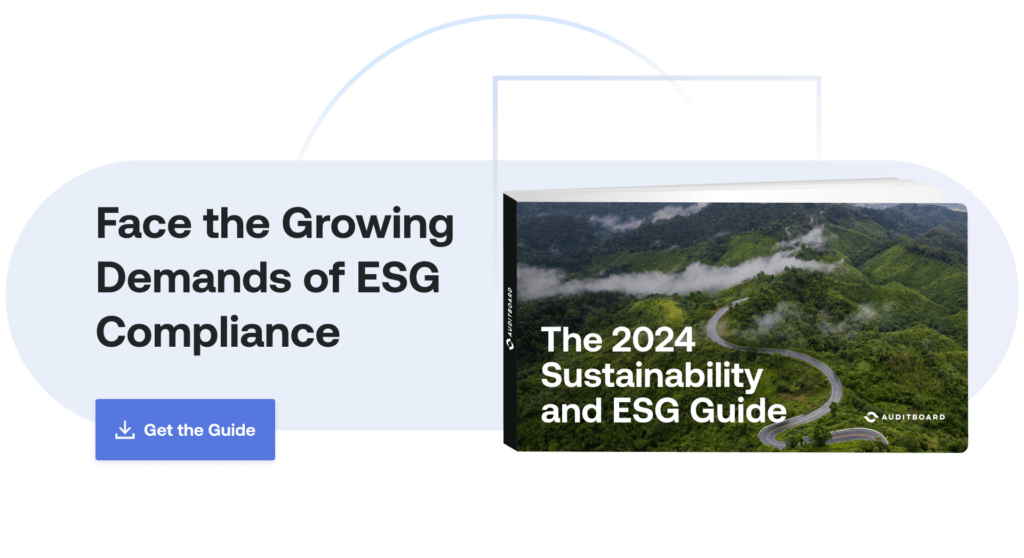
March 7, 2024 • 13 min read
Five Initiatives to Advance Your ESG Maturity for Compliance With the SEC ESG Final Rule

Claire Feeney
As the ESG landscape continues to evolve — most recently with the March 6, 2024 announcement of the U.S. Securities and Exchange Commission’s (SEC’s) final rule for the Enhancement and Standardization of Climate-Related Disclosures, which makes climate-related disclosures mandatory for public companies — it is essential to start building an ESG program sooner rather than later.
The SEC ESG ruling ushers in a new era of corporate transparency, responding to growing demand from investors and public filers for more consistent, comparable, and reliable climate risk reporting. Public companies will be required to begin disclosing material impacts of climate risks and transition activities on their operations and financial statements. The final ruling ultimately excluded Scope 3 requirements, but large filers and large accelerated filers will be required to disclose Scope 1 and 2 greenhouse gas (GHG) emissions if deemed material — with limited and reasonable assurance coming in a phased approach.
These rules will bring more consistent guidance to reporting already taking place — with 90% of the Russell 1000 already reporting on sustainability data. Sustainability teams and their audit, risk, and compliance counterparts must collaborate as they build out internal controls over sustainability reporting — and these rules will bring sustainability reporting on par with financial reporting.
Reliable sustainability reporting requires an ESG program with solid foundations. For a deep dive into building and managing an ESG program, download AuditBoard’s full 2024 Sustainability and ESG Guide, and read on to learn five initiatives organizations can act on to advance their ESG maturity in light of the SEC climate disclosure ruling. These actions can be adopted one at a time or concurrently, and they do not need to be performed in sequential order — the most important part is getting started.
1: Set your sights on mapping your ESG strategy.
Integrating ESG into your business strategy is like setting out on a long journey. Starting may seem daunting, but with a good map and a clear destination, it’s much easier.
- Get your compass. First, you must understand where you’re starting from by performing a materiality assessment, where you identify and prioritize the ESG issues that are most relevant to your business and your stakeholders.
- Set your destination. Once you’ve identified the key issues, you can create strategic ESG goals. This isn’t just about compliance, but about finding opportunities to create value — perhaps by reducing your carbon footprint, improving labor practices, or increasing board diversity.
- Plan your route. Embed ESG considerations into your risk management processes. Just as you’d anticipate roadblocks and detours on a journey, you should be continuously identifying, assessing, and managing ESG risks (and opportunities).
- Communicate with your fellow travelers. Ensure everyone in your organization knows the route by integrating ESG into your company’s DNA. ESG should be embedded in all aspects, from procurement and operations to marketing and human resources.
- Check your progress along the way. Regular monitoring and reporting on ESG metrics will help you stay on track, adjust your strategy if needed, and communicate your performance to stakeholders.
2: Invest in purpose-built technology to support your ESG program and processes.
The power of ESG program management technology in maturing a company’s ESG capabilities can’t be understated. Data analytics, in particular, play a pivotal role by gathering, analyzing, and making sense of a vast array of ESG data. Technology can help the business automate and streamline efforts to identify key ESG trends and monitor their progress. These efficiencies can have a significant impact on helping the business make well-informed, data-driven decisions.
In addition, technology can enable efficient data management and safeguard data integrity. Good quality data is essential for effective ESG strategy, and technological solutions ensure data accuracy, consistency, and ease of access. Moreover, tech platforms are becoming increasingly effective for ESG reporting, helping to simplify the process of collecting, aggregating, and reporting ESG metrics. This, in turn, makes it easier for companies to communicate their sustainability efforts with shareholders, employees, and the public.
Key Capabilities to Look for in ESG Program Management Technology
- Centralizes data and facilitates data collection. Pay attention to not only the interface used to collect data, but if it improves users’ visibility into key information like topics, metrics, locations, etc.
- Easy to use, intuitive interface. This is important for user adoption time and impacts how likely employees are to continue using the technology.
- Quick implementation timeframe. How quickly the technology can be implemented is directly connected to how soon benefits can be realized, and a good indicator of the technology’s ability to integrate into ESG processes.
- Flexibility to evolve. Not only is it important for technology to support your ESG processes, it is equally important that it is flexible enough to adapt to changing business conditions with ease. After all, you don’t want to get stuck with ongoing scope creep, implementation costs, or having to contact support every time you want to change something.
3: Build out your reporting and metrics verification capabilities.
Before companies can report on their ESG performance, they need to first define what ESG issues are material to them, set strategic ESG goals, put in place the right processes, and gather data to track their progress. Reporting is the process of communicating all of this work to the outside world.
Building mature ESG data collection and verification processes ensures you can consistently and accurately measure, track, and report on your ESG performance over time. These capabilities involve not only the output needed for reporting, but also the systems and processes for data collection, data management, and data analysis. Without these capabilities, your report may be inaccurate, incomplete, or not comparable from one period to another, which could mislead stakeholders and undermine your credibility.
In addition, metrics verification helps validate the accuracy and reliability of the ESG data in your report. This is essential because it provides both you and your stakeholders confidence in the data you’re reporting. Without robust metrics verification, you run the risk of reporting incorrect data, which could have legal implications and damage your reputation.
To build out your data collection and metrics verification capabilities, consider:
- What are the outputs that you need? An annual sustainability report, timely responses to RFPs, data available to internal stakeholders, etc. are important to consider.
- What tools and systems are you using to collect, manage, and analyze data? Are they reliable and have they been vetted by others in the industry and/or your organization?
- What formats do your outputs need to be in? Keep in mind the format that your marketing agency may need to create the annual report materials. The goal is to have verified and trustworthy ESG information that can be turned into impactful reports — and that doesn’t open your organization to accusations of greenwashing.
4: Build a strong controls program.
Building controls and governance around ESG data is paramount because it enhances the accuracy, consistency, and reliability of the data. This, in turn, strengthens the credibility of your ESG disclosures and builds trust with your stakeholders. Just as financial data has rigorous controls to ensure its integrity, the same principle should apply to ESG data given its growing significance in decision-making for investors, regulators, and other stakeholders.
To create controls and governance for ESG data, several steps can be taken:
- Develop clear data management policies and procedures
- Implement data quality checks
- Establish a clear chain of custody
- Train and educate staff
- Use technology to support data management
5: Adopt a creative approach.
In an environment where resources are limited and regulations are still evolving, a creative mindset can be a game changer for advancing ESG capabilities. While there are challenges in managing ESG, a creative mindset can turn these challenges into opportunities for innovation, differentiation, and leadership.
A creative mindset can help businesses find value in ESG that may not be immediately obvious. Companies can look at ESG not just as a compliance requirement, but as an opportunity to create value and differentiate themselves. For example, they could use their ESG efforts to enhance their brand, attract talent, or drive innovation.
Additionally, in the face of regulatory ambiguity, creativity can help companies become leaders instead of followers. Instead of waiting for regulations to define what they should do, companies can define their own ESG goals and standards. This not only positions them as leaders in the eyes of stakeholders, but it can also give them a head start when regulations do become more defined.
Finally, a creative mindset can also foster a culture of resilience and adaptability. As ESG landscapes evolve, companies that are flexible and open-minded are better positioned to adjust their strategies and continue to make progress.
Ultimately, embedding ESG into a company’s culture and operations takes time. Reaching a state of ESG maturity is a journey that requires careful planning, strategic implementation, and a proactive mindset. The sooner a company starts on this journey, the sooner it can reap the benefits of reliable and accurate ESG risk data to support business.
There’s No Time Like the Present to Start Maturing Your ESG Practices
The more time and effort spent on ESG initiatives across the business, the more incremental improvements there will be, allowing the business to advance its ESG capabilities over time. Embracing ESG maturity is not only about being a good corporate citizen — it’s also smart business.
The journey towards ESG maturity is an ongoing one that requires dedication, continuous improvement, and a commitment to creating long-lasting positive impact. By embracing this transformative journey, organizations can drive meaningful change, shape a more sustainable future, and meet the expectations of stakeholders while realizing the tangible benefits of ESG integration.
To learn how organizations today are managing ESG risk and reporting — and to measure your own organization’s ESG maturity — get your free copy of AuditBoard’s ESG Maturity Benchmarking Report: Accelerating ESG Transformation. For a deeper dive into ESG from planning and scoping to governance and controls, data management, and reporting, download AuditBoard’s 2024 Sustainability and ESG Guide.
About the authors

Claire Feeney is a Senior Product Marketing Manager at AuditBoard focused on ESG and RiskOversight. In her role, she helps support organizations in transforming their enterprise risk management and sustainability programs. Prior to joining AuditBoard, Claire worked in product marketing at OneTrust, VMware, and Infor. Connect with Claire on LinkedIn.
You may also like to read


CSRD reporting requirements: What every compliance team must know

Navigate FedRAMP: A step-by-step checklist

Best SOC 2 compliance software for long-term readiness

CSRD reporting requirements: What every compliance team must know

Navigate FedRAMP: A step-by-step checklist
Discover why industry leaders choose AuditBoard
SCHEDULE A DEMO




